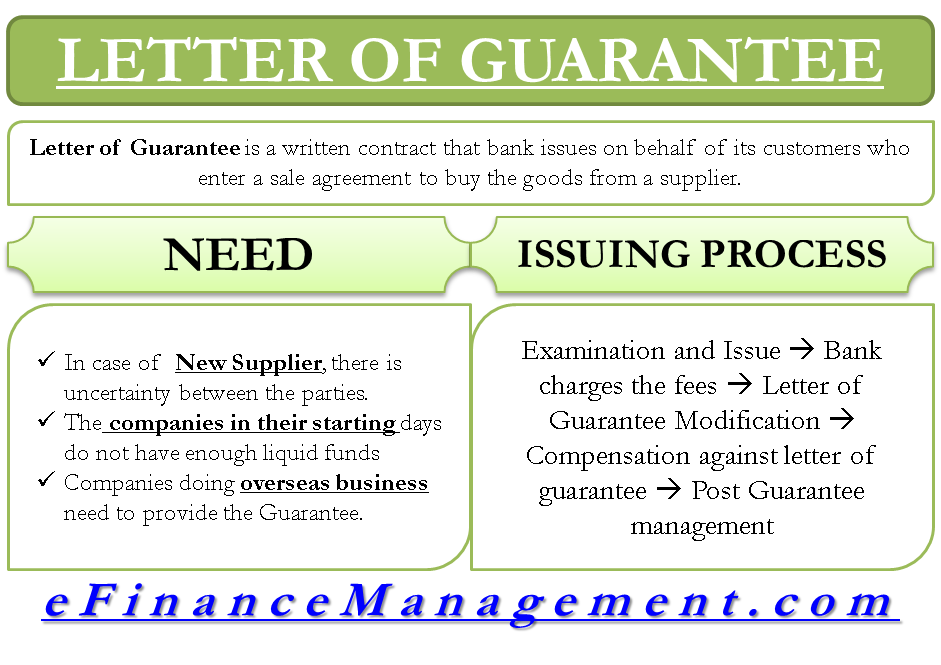A letter of guarantee is a written contract that the bank issues on behalf of its customers who enter a sale agreement to buy the goods from a supplier. It assures the supplier that they will receive the payment even if the customer of the bank defaults. To get the letter of guarantee, the customer has to apply for it. When the bank feels comfortable with the risk, they charge the customer an annual fee for backing them with the letter of guarantee.
It can also be issued for technological trade, construction, financing from financial institutions, leases, and a large order of export and import.
Basics of the Letter of Guarantee
The letter of guarantee is required when one party involved in the agreement is uncertain that the other party will fulfill its financial obligation. This is of extreme importance when it involves high-value transactions. However, the thing to remember is that the bank may not cover the whole debt under the letter of guarantee.
The bank and the client negotiate to decide how much amount the bank will cover. For providing this service, the bank charges a fee. The fee that the bank charges are a certain percentage. The bank must pay in case the customer defaults.
Need for Letter of Guarantee
In the case of a New Supplier
The new supplier does not have a history of the transactions with the customer, so there is uncertainty between the parties. To overcome these uncertainties, the customer provides a letter of guarantee to the suppliers. This practice is common in cases of the purchase of costly products and in a case where the supplier does not give the trade credit.
Also Read: Bank Guarantee
Startup Company
The companies in their starting days do not have enough liquid finance to purchase the goods. So they ask the bank to issue a letter of guarantee on their behalf. The supplier does not have the transaction history with the customer, so they cannot judge the ability of the customer to pay and fulfill its obligations on time.

Supplier Outside of a Usual Trading Area
Companies doing business overseas need to provide a letter of guarantee to the suppliers. They show their interest and commitment to pay for the product by doing this. Sometimes the suppliers incur certain additional costs in supplying the goods outside the country. They need the guarantee that they will receive payment even if the customer fails to pay.
Issuing Process
The customer requests for a letter of guarantee from the bank when the supplier asks for one or when there is uncertainty in the customer’s ability to pay. The bank follows the following process:
Examination and Issue
When the bank receives the request for the letter of guarantee, it must verify that the customer qualifies or not. The bank scrutinizes the underlying transactions, past transaction records, and other relevant materials. It can ask the customer for any additional information and document if required.
Fee
The bank charges a fee for providing this service to its customers. The bank charges the fee on the basis of the principles and rate determined by the system of the issuing bank.
Letter of Guarantee Modification
Before the issue of the letter of guarantee, the bank can make the modification on the request of the customer or the supplier. The amendment made can be regarding the validity period, the underlying asset, etc.
Compensation Against the Letter of Guarantee
After delivering goods to the customer, the supplier made a claim for compensation from the guaranteeing bank within the validity period. The bank notifies the customer of the request. The bank will then examine the claim document and verify that they comply with the clauses of the letter of guarantee. After checking that everything is in order, the bank makes the payment to the supplier. The payment made to the supplier is equal to the amount of work done.
Post Guarantee Management
After making the payment to the suppliers, the bank updates the customer’s account to show the changes. It also stores the letter of guarantee and verifies that they show the actual transaction. Upon confirmed relief from the letter of guarantee liability, the bank revokes the guarantee and consequently recovers the credit line of the guarantee customer or refunds the surplus.

